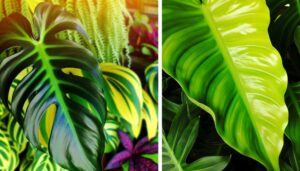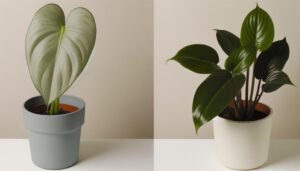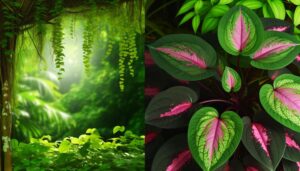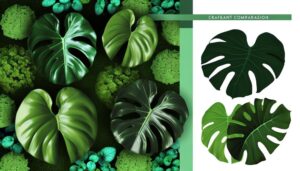Philodendron Hope Vs Selloum: Key Differences and Care Guide
Philodendron Hope and Philodendron Selloum, both hemiepiphytes from tropical South America, belong to the Araceae family. Philodendron Hope features deeply lobed, narrower, and glossy leaves with sharply incised contours, while Philodendron Selloum has broader, matte, and leathery leaves.
Growth differences are notable; Hope is compact and bushy with larger, elongated leaves and an upright form, whereas Selloum displays sprawling, tree-like growth and climbing tendencies. Both thrive in well-drained, nutrient-rich soil under bright, indirect light and require vigilant moisture management.
These distinctions encompass most of their morphological and ecological adaptations. More nuanced differences await further exploration.
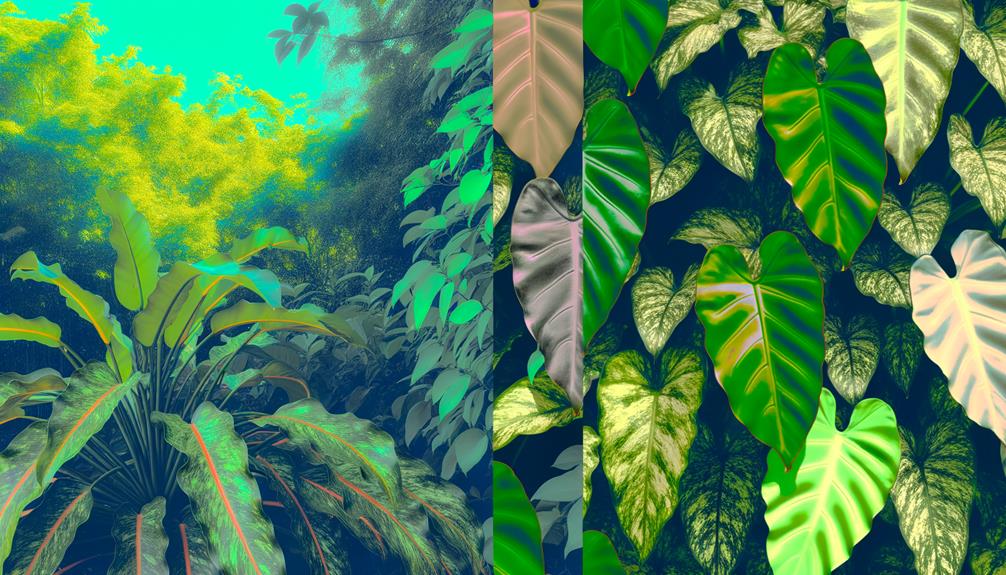
Key Takeaways
- Philodendron Hope has deeply lobed, narrower leaves, while Philodendron Selloum has wider, less segmented leaves.
- Philodendron Hope leaves are vibrant green and glossy; Philodendron Selloum leaves are darker green and matte.
- Philodendron Hope exhibits a compact, bushy growth, whereas Philodendron Selloum has a sprawling, tree-like growth habit.
- Philodendron Hope is upright and self-supporting; Philodendron Selloum is a climbing, vining plant.
- Both require bright, indirect light and consistently moist, well-drained soil for optimal growth.
Philodendron Hope vs. Selloum: Key Features
| Feature | Philodendron Hope | Philodendron Selloum |
|---|---|---|
| Scientific Name | Philodendron bipinnatifidum | Philodendron bipinnatifidum |
| Common Name | Philodendron Hope | Philodendron Selloum |
| Leaf Shape | Broad, deeply lobed leaves | Large, deeply divided leaves |
| Leaf Size | Medium to large | Large |
| Growth Habit | Compact, bushy | Sprawling, large |
| Mature Height | 3-5 feet | Up to 10 feet indoors |
| Light Requirements | Bright, indirect light | Bright, indirect to partial shade |
| Watering Needs | Moderate, allow soil to dry slightly | Moderate, prefers moist soil |
| Humidity Requirements | High humidity, tropical environment | High humidity, tropical environment |
| Toxicity | Toxic to pets and humans | Toxic to pets and humans |
| Growth Rate | Moderate | Fast |
| Maintenance | Low to moderate | Low to moderate |
Origins and Background
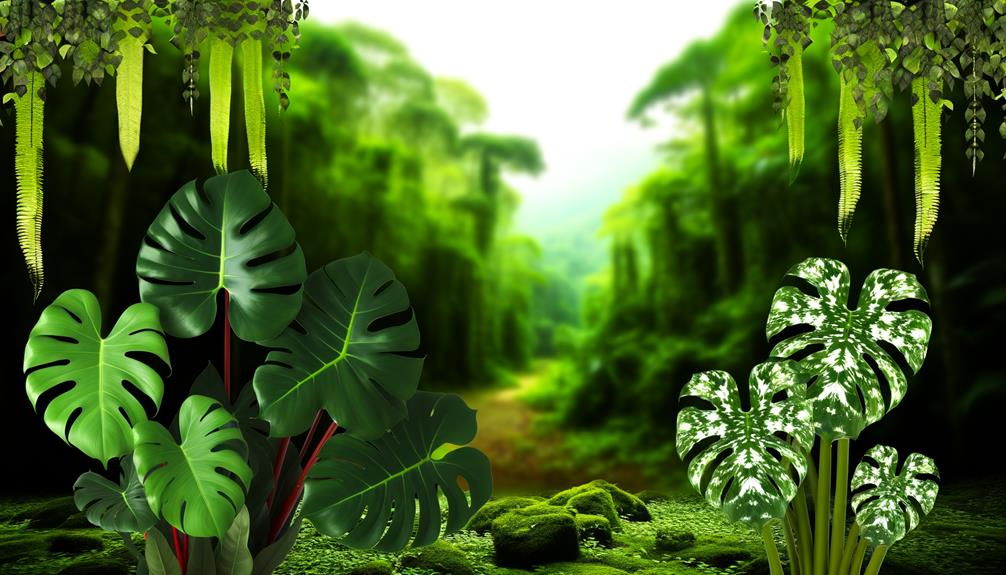
Philodendron Hope (Philodendron bipinnatifidum) and Philodendron Selloum (Philodendron selloum) both belong to the Araceae family and are native to the tropical regions of South America, particularly Brazil.
As hemiepiphytes, these species exhibit a growth pattern that allows them to start life as epiphytes on other plants before rooting in the soil. They thrive under humid conditions and partial to full shade, emulating their natural understory habitat in tropical rainforests.
Both species are adapted to nutrient-rich, well-draining soil and exhibit a robust tolerance to varying moisture levels. Their evolutionary adaptations include aerial roots, which facilitate nutrient absorption and structural support.
Understanding these foundational aspects of their origins provides a critical context for further comparative analysis.
Appearance and Foliage
The morphological distinctions between Philodendron Hope and Selloum are evident in their leaf morphology, pigmentation, and surface characteristics, as well as their respective growth patterns.
Philodendron Hope exhibits a more compact growth habit with less pronounced lobes, contrasting with the deeply lobed and expansive leaves of Philodendron Selloum.
Additionally, variances in chlorophyll concentration and epidermal texture contribute to their unique visual and tactile properties.
Leaf Shape Differences
Distinguished by their morphological characteristics, the leaves of Philodendron Hope exhibit a more deeply lobed structure compared to the broader, less intricate foliage of Philodendron Selloum.
This distinction can be analyzed through several key aspects:
- Lobe Depth: Philodendron Hope leaves possess pronounced indentations, creating a deeply lobed appearance, while Philodendron Selloum leaves are less segmented and display shallower lobes.
- Leaf Width: Philodendron Hope leaves are generally narrower, enhancing their segmented look, whereas Philodendron Selloum leaves are wider, contributing to a more uniform and expansive appearance.
- Edge Contours: The marginal contours of Philodendron Hope leaves are sharply incised, producing an almost frilly aesthetic. In contrast, Philodendron Selloum leaves have smoother and more rounded edges, offering a subtler visual effect.
These distinctions are pivotal for accurate botanical identification and aesthetic appreciation.
Color and Texture
Leaf color and texture serve as critical indicators in differentiating between Hope and Selloum, with Hope showcasing a vibrant green hue and a glossy, smooth surface, while Selloum presents a slightly darker green with a matte, leathery texture. These differences in pigmentation and epidermal characteristics are significant for accurate identification and classification.
| Attribute | Philodendron Hope | Philodendron Selloum |
|---|---|---|
| Leaf Color | Vibrant green | Slightly darker green |
| Leaf Texture | Glossy, smooth | Matte, leathery |
| Epidermal Features | Reflective surface due to cuticle layer | Non-reflective, thicker epidermis |
The chromatic intensity and textural nuances are not merely aesthetic but are indicative of their adaptive strategies and habitat preferences. The glossy leaves of Hope may aid in light reflection and water runoff, whereas Selloum’s leathery texture provides durability in various environmental conditions.
Growth Habit Comparison
Philodendron Hope exhibits a compact, bushy growth habit with densely packed, deeply lobed foliage, while Philodendron Selloum tends to develop a more sprawling, tree-like structure with larger, more widely spaced leaves.
The morphological distinctions between these two species are significant:
- Leaf Architecture: Philodendron Hope’s leaves are smaller and more intricate in their lobation compared to the expansive, less divided leaves of Philodendron Selloum.
- Growth Form: Hope maintains a more rounded, shrub-like form, whereas Selloum often forms a trunk-like base, contributing to its arboreal appearance.
- Spatial Occupation: The compact nature of Hope allows for denser, indoor cultivation, while Selloum’s expansive growth requires more spatial accommodation, typically suited for outdoor environments or larger indoor spaces.
Growth Habits

In evaluating the growth habits of Philodendron Hope and Philodendron Selloum, one must consider both leaf size and overall structural tendencies.
Philodendron Hope shows larger, more expansive leaves and maintains an upright growth habit, contrasting with Philodendron Selloum, which shows smaller leaves and a semi-climbing nature.
These morphological and structural differences greatly impact their environmental adaptability and spatial requirements.
Leaf Size Comparison
The comparative morphology of Philodendron Hope and Selloum reveals distinct variations in leaf size. Philodendron Hope typically produces broader, more elongated foliage compared to the more deeply lobed and compact leaves of Selloum. These differences can be elucidated through the following observations:
- Leaf Dimensions:
- Philodendron Hope’s leaves can extend to approximately 24 inches in length and 18 inches in width.
- Selloum’s leaves are generally smaller, averaging 18 inches in length and 12 inches in width.
- Lobation:
- Philodendron Hope exhibits less pronounced lobes, resulting in a more unified leaf structure.
- Selloum’s leaves are characterized by deep, serrated lobes, giving a more segmented appearance.
- Leaf Texture:
- Philodendron Hope’s leaves are typically smoother and less rigid compared to the more robust and textured leaves of Selloum.
Climbing Vs. Upright
Distinct growth habits differentiate Philodendron Hope and Selloum, with the former showing an upright, self-supporting structure and the latter showing a vining, climbing tendency.
Philodendron Hope (Philodendron bipinnatifidum) displays an arborescent growth form, characterized by a vertical stem that supports its large, pinnate leaves. This self-sustaining habit allows it to thrive without external support.
In contrast, Philodendron Selloum (Philodendron bipinnatifidum ‘Selloum’) is a hemiepiphyte, often showing scandent growth. It relies on aerial roots to anchor itself to trees or trellises, facilitating its upward climb.
This divergent growth morphology influences their ecological adaptability and care requirements, with Philodendron Hope needing less structural support compared to the inherently climbing Philodendron Selloum. Understanding these distinctions is essential for best cultivation practices.
Light Requirements
Both Philodendron Hope and Philodendron Selloum flourish in bright, indirect light, but they can also tolerate moderate shade, making them versatile choices for various indoor environments. These species exhibit phototropic behavior, responding adaptively to light sources.
Here are key observations regarding their light requirements:
- Light Intensity: Best growth occurs under light levels of 10,000-20,000 lux. Excessive direct sunlight may cause chlorophyll degradation, leading to leaf burn.
- Duration: They require approximately 10-12 hours of light daily to maintain robust photosynthesis rates.
- Adaptability: Both species can endure lower light conditions (3,000-5,000 lux), yet prolonged low light may reduce leaf size and hinder overall essentiality.
Watering Needs
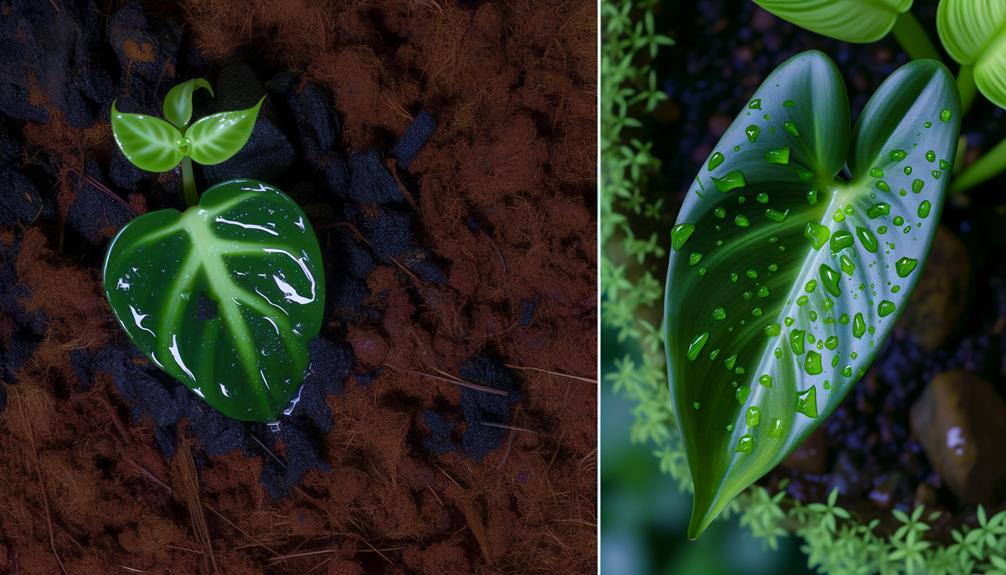
Philodendron Hope and Philodendron Selloum require a watering schedule that maintains the soil consistently moist, yet well-drained, to prevent root rot and promote ideal growth. Both species display mesophytic characteristics, requiring moderate moisture levels.
It is crucial to employ a thorough watering technique, making sure water permeates through the substrate and drains effectively. The substrate’s moisture content should be monitored using a soil moisture sensor to guarantee optimal hydration.
Overwatering can lead to anaerobic conditions, promoting pathogenic fungi. Conversely, underwatering may cause hydric stress, appearing as chlorosis and wilting.
Regular observation of leaf turgor and soil moisture levels will guide appropriate watering intervals, ensuring the maintenance of homeostatic water balance within the rhizosphere.
Soil Preferences
A well-aerated, organically rich, and slightly acidic to neutral soil composition is essential for ideal growth and development of Philodendron Hope and Selloum. These species require a substrate that guarantees adequate drainage while retaining sufficient moisture and nutrients.
The recommended soil mix should include:
- Organic Matter: Integrate compost or peat moss to enhance soil fertility and structure.
- Aeration Components: Utilize perlite or coarse sand to enhance soil porosity and oxygen availability to roots.
- pH Balance: Maintain a pH range between 5.5 and 7.0 to optimize nutrient uptake and prevent root stress.
Such a soil composition minimizes risks of waterlogging and nutrient deficiencies, thereby promoting robust vegetative growth and overall plant health.
Common Pests and Issues
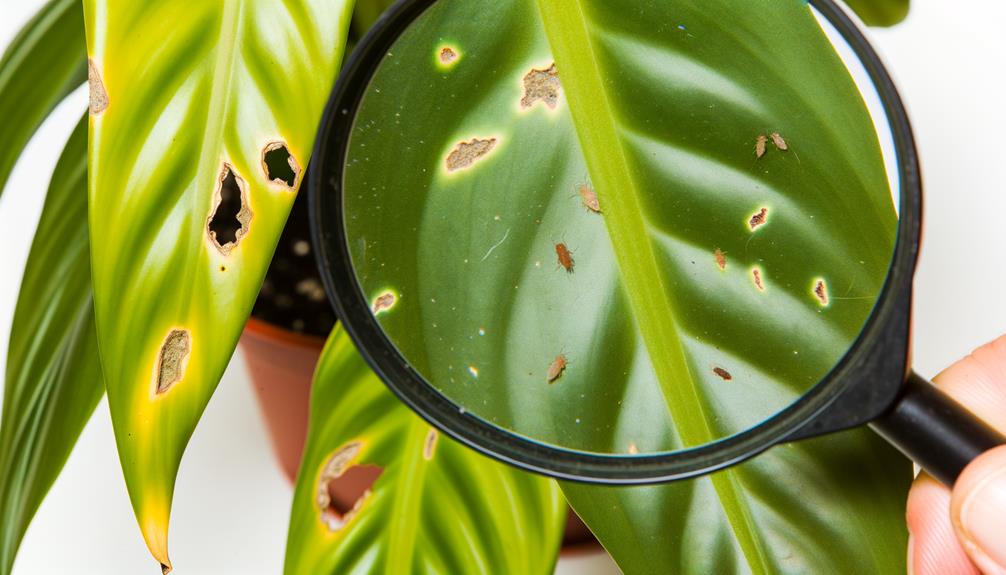
Encountering common pests and issues in the cultivation of Philodendron Hope and Selloum can greatly impede plant health and vigor, necessitating vigilant monitoring and proactive management strategies.
Aphids, mealybugs, and spider mites are prevalent arthropod pests that can cause chlorosis, stunted growth, and necrosis. These pests typically congregate on the abaxial leaf surface, where they extract phloem sap.
Fungal pathogens such as Phytophthora and Pythium can induce root rot, presenting as wilting despite adequate hydration. Bacterial leaf spot, caused by Xanthomonas campestris, manifests as water-soaked lesions, necessitating immediate isolation of infected specimens.
Employing integrated pest management (IPM) techniques, including biological control agents, precise watering practices, and systemic insecticides, can mitigate these risks and promote robust plant health.
Conclusion
To sum up, Philodendron ‘Hope’ and ‘Selloum’ display clear yet slight differences in their backgrounds, physical traits, and gardening needs. Though both plants show toughness and flexibility, subtle distinctions in light, water, and soil preferences highlight the significance of customized care.
Diligence in pest control and environmental conditions guarantees excellent growth and health. These plant specimens, though appearing unassuming, provide an elegant addition to various plant collections, necessitating accurate cultivation methods for continuous well-being and aesthetic charm.

